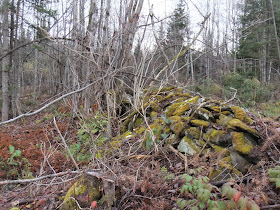They
are a long way in, over a rocky road that is barely possible at times, even crawling
along in four wheel drive. The term “openings” was new to me, but it is what
the locals call the fields left by long-gone homesteaders. Holes in the forest
is what they are, openings.
A
friend who had grown up in the area showed me the way in. At a certain point, you
have to park and walk the rest of the way, but four wheelers make it in and out
to a couple of nearby camps. The snowmobilers maintain a bridge over a large
stream that flows north, which makes crossing easier.
The
area before the openings is logged hard, so it is good grouse country. It’s
also flat, at least for our neck of the woods, and thick, so I find it easy to
get “turned around” there. We’ve taken a lot of birds out of those woods.
But
the openings are special, where you step onto grass and large pines stand
overlooking on a knoll, with blue sky stretched overhead. The forest tries hard
to creep back in, and I am sure it will with no one mowing the fields. Beneath
a mammoth white pine there’s a small cellar hole. I always wonder if the pine
stood there when the house still remained.
What
did the people grow? The summers are short and the winters long. Was there a
barn? Maybe this coming summer I’ll walk in there with the dogs to look around again.
Could there have been more than one family? It is miles to the nearest village.
I
get distracted around abandoned home sites. If we locate their dump it’s like
finding a gold mine. Everything must have been precious in those hard times, and
I’m sure little was thrown out unless it was totally useless. But their useless
might be a treasure to me. I’ve spent hours, sitting on my butt, digging out
old bottles and unidentifiable pieces of rusted iron, while the guns rested
against trees and our dogs waited impatiently.
 |
| An ancient stone wall, sagging and moss covered. |
Where
did the people go? What drove them away? The rocky soil? Cold winters? The
isolation?
Did
they leave during the chilly years after the volcano Krakatoa erupted in 1883?
It took five years for the world’s weather to get back to normal. Mount Tambora
did the same thing in 1816, but made it so cold that it was referred to as the
“year without a summer”. It snowed in June and water on ponds froze an inch
thick. Frosts happened in every month, disrupting agriculture in New England
and Europe to the point that thousands starved. I read once that between 10 and
15 thousand left Vermont during that time and headed west, hoping for a better
climate and fewer rocks. But if those openings had been abandoned that long ago,
I think they would have grown in long before now. Maybe not.
So
I’ll probably never know for certain. Those openings, while they still remain,
are a testament to tough people that tried to carve out a dream. The stone
lined cellar holes will last long after the fields have grown in, but
eventually all will be forgotten.
I
will visit them all again, and wonder.

No comments:
Post a Comment